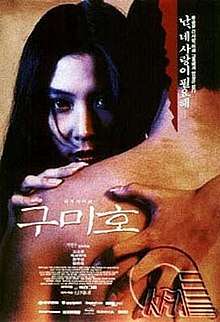The Fox with Nine Tails
The Fox with Nine Tails (Korean: 구미호; RR: Gumiho) is a 1994 South Korean film. It was the first feature film by the director Park Heon-su.[1] It was also the film debut of the leading actors Ko So-young and Jung Woo-sung, who later starred together in Beat (1997) and Love (1999).[2]
| The Fox with Nine Tails | |
|---|---|
 Theatrical poster | |
| Hangul | 구미호 |
| Hanja | 九尾狐 |
| Revised Romanization | Gumiho |
| McCune–Reischauer | Kumiho |
| Directed by | Park Heon-su |
| Produced by | Shin Chul Yu Hyeok-ju Ha Gwang-hwi |
| Written by | Park Heon-su |
| Starring | Ko So-young Jung Woo-sung |
| Music by | Lee Dong-jun |
| Cinematography | Ku Jung-mo |
| Edited by | Park Soon-duk |
| Distributed by | ShinCine Communications |
Release date |
|
Running time | 107 minutes |
| Country | South Korea |
| Language | Korean |
Plot
Harah is a kumiho in the guise of a beautiful young woman, who desperately desires to become human. She falls in love with a charming taxi driver, Hyuk, and tries to use him to achieve her goal. But an agent from hell has been sent to track down and destroy her.
Cast
- Ko So-young ... Harah
- Jung Woo-sung ... Hyuk
- Dokgo Young-jae
- Bang Eun-hee
- Lee Ki-young
- Lee Gun-hee
- Seo Gi-woong
- Kwon Hae-hyo
- Ahn Suk-hwan
- So Il-seop
Production
The Fox with Nine Tails was the first Korean film to use computer-generated imagery and it foreshadowed other changes in the Korean film industry by pioneering the fantasy genre and using chaebol funds from the Byuksan Group to cover the budget.[3] The opening scenes of the film depicting hell used approximately 200 extras, with the set costing in the region ₩100,000,000 (US$125,000).[1]
Release
The Fox with Nine Tails was released on 24 July 1994.[1]
References
- "The fox with nine tails (Gumiho)". Korean Movie Database. 1994. Retrieved 28 December 2008.
- "Ko So-young". Koreanfilm.org. Retrieved 28 December 2008.
- "Jung Woo-sung". Koreanfilm.org. Retrieved 28 December 2008. - "Advances in Visual Technology", Introduction to Korean Film pp. 369. Korean Film Council. Retrieved 28 December 2008. Archived 15 November 2008 at the Wayback Machine